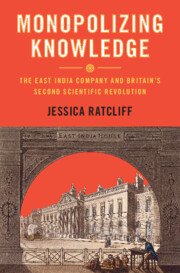Refine search
Actions for selected content:
10306 results in History of science: general interest
Dedication
-
- Book:
- Monopolizing Knowledge
- Published online:
- 02 January 2025
- Print publication:
- 16 January 2025, pp v-vi
-
- Chapter
- Export citation
Conclusion
- from Part II - From Company Science to Public Science, 1813–1858
-
- Book:
- Monopolizing Knowledge
- Published online:
- 02 January 2025
- Print publication:
- 16 January 2025, pp 257-261
-
- Chapter
- Export citation
Part I - The Making of Company Science, 1600–1813
-
- Book:
- Monopolizing Knowledge
- Published online:
- 02 January 2025
- Print publication:
- 16 January 2025, pp 13-100
-
- Chapter
- Export citation
1 - Science under the Company before Company Science
- from Part I - The Making of Company Science, 1600–1813
-
- Book:
- Monopolizing Knowledge
- Published online:
- 02 January 2025
- Print publication:
- 16 January 2025, pp 15-33
-
- Chapter
- Export citation
Contents
-
- Book:
- Monopolizing Knowledge
- Published online:
- 02 January 2025
- Print publication:
- 16 January 2025, pp vii-viii
-
- Chapter
- Export citation
Copyright page
-
- Book:
- Monopolizing Knowledge
- Published online:
- 02 January 2025
- Print publication:
- 16 January 2025, pp iv-iv
-
- Chapter
- Export citation
5 - Systematic Possession
- from Part II - From Company Science to Public Science, 1813–1858
-
- Book:
- Monopolizing Knowledge
- Published online:
- 02 January 2025
- Print publication:
- 16 January 2025, pp 147-178
-
- Chapter
- Export citation
6 - Becoming National
- from Part II - From Company Science to Public Science, 1813–1858
-
- Book:
- Monopolizing Knowledge
- Published online:
- 02 January 2025
- Print publication:
- 16 January 2025, pp 179-211
-
- Chapter
- Export citation
Introduction
-
- Book:
- Monopolizing Knowledge
- Published online:
- 02 January 2025
- Print publication:
- 16 January 2025, pp 1-12
-
- Chapter
- Export citation
Acknowledgments
-
- Book:
- Monopolizing Knowledge
- Published online:
- 02 January 2025
- Print publication:
- 16 January 2025, pp xi-xii
-
- Chapter
- Export citation
Bibliography
-
- Book:
- Monopolizing Knowledge
- Published online:
- 02 January 2025
- Print publication:
- 16 January 2025, pp 262-284
-
- Chapter
- Export citation
7 - The Commercializing Mission
- from Part II - From Company Science to Public Science, 1813–1858
-
- Book:
- Monopolizing Knowledge
- Published online:
- 02 January 2025
- Print publication:
- 16 January 2025, pp 212-256
-
- Chapter
- Export citation

Monopolizing Knowledge
- The East India Company and Britain's Second Scientific Revolution
-
- Published online:
- 02 January 2025
- Print publication:
- 16 January 2025
Nima Bassiri, Madness and Enterprise: Psychiatry, Economic Reason, and the Emergence of Pathological Value Chicago: University of Chicago Press, 2024. Pp. 344. ISBN 978-0-226-83089-6. $35.00 (paper).
-
- Journal:
- The British Journal for the History of Science / Volume 58 / Issue 3 / September 2025
- Published online by Cambridge University Press:
- 26 December 2024, pp. 575-576
- Print publication:
- September 2025
-
- Article
- Export citation
Nuno Vila-Santa, Knowledge Exchanges between Portugal and Europe: Maritime Diplomacy, Espionage, and Nautical Science in the Early Modern World (15th–17th Centuries) Amsterdam: Amsterdam University Press, 2024. Pp. 372. ISBN 978-90-485-6047-9. €141.00 (hardback).
-
- Journal:
- The British Journal for the History of Science / Volume 58 / Issue 3 / September 2025
- Published online by Cambridge University Press:
- 20 December 2024, pp. 577-578
- Print publication:
- September 2025
-
- Article
- Export citation
Guillaume Carnino, Liliane Hilaire-Perez and Jérôme Lamy (eds.),Global History of Techniques: 19th–21st Centuries Turnhout: Brepols, 2024. Pp. 781. ISBN 978-2-503-59151-3. €120.00 (hardback).
-
- Journal:
- The British Journal for the History of Science / Volume 58 / Issue 3 / September 2025
- Published online by Cambridge University Press:
- 19 December 2024, pp. 585-586
- Print publication:
- September 2025
-
- Article
- Export citation
Aaron Bateman, Weapons in Space: Technology, Politics, and the Rise and Fall of the Strategic Defense Initiative Cambridge, MA: MIT Press, 2024. Pp. 336. ISBN 978-0-262-54736-9. $60.00 (paperback).
-
- Journal:
- The British Journal for the History of Science / Volume 58 / Issue 3 / September 2025
- Published online by Cambridge University Press:
- 19 December 2024, pp. 583-584
- Print publication:
- September 2025
-
- Article
- Export citation
Michael Batty, The Computable City: Histories, Technologies, Stories, Predictions Cambridge, MA: MIT Press, 2024. Pp. 544. ISBN 978-0-262-54757-4. $45.00 (paperback).
-
- Journal:
- The British Journal for the History of Science / Volume 58 / Issue 3 / September 2025
- Published online by Cambridge University Press:
- 19 December 2024, pp. 589-590
- Print publication:
- September 2025
-
- Article
- Export citation
Essay review: the fictive history of Victorian science and empire
-
- Journal:
- The British Journal for the History of Science / Volume 58 / Issue 1 / March 2025
- Published online by Cambridge University Press:
- 19 December 2024, pp. 133-135
- Print publication:
- March 2025
-
- Article
-
- You have access
- Open access
- HTML
- Export citation
Kirsten Moore-Sheeley, Nothing but Nets: A Biography of Global Health Science and Its Objects Baltimore: Johns Hopkins University Press, 2023. Pp. 248. ISBN 978-1-4214-4757-5. $49.95 (hardcover).
-
- Journal:
- The British Journal for the History of Science / Volume 58 / Issue 3 / September 2025
- Published online by Cambridge University Press:
- 19 December 2024, pp. 551-552
- Print publication:
- September 2025
-
- Article
- Export citation
